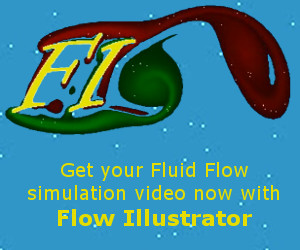Theoretical Fluid Mechanics
Centrifuges
Centrifuges with hydraulic drive
![[A sketch of a centrifgure with hydraulic drive]](./images/Centrifuges/CentrifugeSketch.png)
![[A photograph of a centrifgure with hydraulic drive]](./images/Centrifuges/CentrifugePhoto.png)
Fig. A sketch and a photograph of a centrifgure with hydraulic drive.
Centrifuges are used for separating solid particles from the fluid of different density, for example for cleaning oil in car engines. High rotation speed of the rotor creates large centrifugal forces, pulling heavier particles to the side of the rotor, where they stay until removed during a regular maintenance, or from where they are removed continuously by a special mechanism. Frequently, the rotor of the centrifuge is driven by a separate electric motor, or by a shaft from the car engine. A sketch of a centrifuge with a hydraulic drive is shown in Figure. In such a centrifuge the fluid is pumped into the rotor and exits through the nozzles. The nozzle thrust creates torque driving the centrifuge, thus eliminating the need for a separate motor. Notice the nozzles on the photograph of the centrifuge.
A centrifuge with hydraulic drive is an interesting object from the fluid dynamics point of view. To achieve high efficiency, the hydraulic resistance of the inner, quickly rotating with the rotor, passages should be minimised. At the same time the fluid should pass through an area far away from the axis of rotation, where the centrifugal force is greater. Nozzle efficiency is crucial. The air in the gap between the rotor and the centrifuge cover also moves, and the air friction makes a significant contribution. Jets from the nozzles might break down into a fine spray and hit the rotor, slowing it down. Optimizing such a device is quite a challenging task, but this can, indeed, be done.

Try it, it is easy and it is fun!
Timeline:
- Will be in Lille 11-12 December 2025. On 12th, will give a talk at LMFL Fluid Mechanics Webinar (Note the non-standard time, 2pm!).
- Attended and gave a plenary talk at FMFP 2024, Aligarh (U.P), India, 20-23 December 2024.
- Attended the
Oberwolfach Workshop 2431 - Polynomial Optimization for Nonlinear Dynamics: Theory, Algorithms, and Applications
at the Mathematisches Forschungsinstitut Oberwolfach, Germany 28 July - 2 August 2024. - Gave a talk on
Studying fluid flows with auxiliary functions and LMIs
at the IFAC World Congress, held in Yokohama, Japan on 8-14th July 2023. -
Gave a talk on
Bounding time averages: a road to solving the problem of turbulence
at Institut de Mathématiques de Bordeaux, Bordeaux, May 4, 2023. - Gave a talk on QSQH theory of scale interaction in near-wall turbulence: the essence, evolution, and the current state at Institut Pprime, Bordeaux on May 3, 2023.
- Talk at Department of Engineering, University of Cambridge, 4 November 2022, as part of the CUED Fluids seminar series, video: "Accelerating time averaging by adding a Lie derivative of an auxiliary function". Joint work with Owen Tutty and Hanying Yang.
- On August 15, 2022, gave (online) an invited talk "On the path to solving the problem of turbulence" at the International Symposium on Turbulence in Memory of Chou Pei-Yuan's 120th anniversary of birth (IST2022).
- On July 22, 2022, gave (online) a talk "Bounds for time averages: towards solving the problem of turbulence" at the Harbin Institute of Technology Fluid Mechanics Seminar.
- In January-April 2022 was a long-term participant of the Isaac Newton Institute Programme "Mathematical aspects of turbulence: where do we stand?". Gave two talks:
Bounding time averages
andHow quasi-steady is the modulation of near-wall turbulence by large-scale structures?
(with Yunjiu Yang). -
Gave a talk
Auxiliary functionals: a path to solving the problem of turbulence
at The Seminar in the Analysis and Methods of PDE (SIAM PDE) on March 4, 2021. Links to the abstract and the video. - Gave a talk on Extension of QSQH theory to all velocity components, abstract and video, at IPAM, Wednesday, January 13, 2021, as part of the workshop on Transport and Mixing in Complex and Turbulent Flows. Great talks, all recorded, highly recommended.
-
Gave a talk
Accelerating time averaging
at 73rd Annual Meeting of the APS Division of Fluid Dynamics, November 22, 2020: abstract and video. - 2020: the virus ... living online ... most of the year working on additional administration and teaching related to the pandemic ...
- Gave a talk at SIAM Conference on Applications of Dynamical Systems (DS19), , Snowbird, Utah, U.S, May 19 - 23, 2019.
- Gave a keynote lecture at the workshop Scientific Computing Across Scales: Extreme Events and Criticality in Fluid Mechanics, The Fields Institute, Toronto, April 15-18, 2019.
- Gave a talk at European Drag Reduction and Flow Control Meeting 26-29 March 2019, Haus der Kirche, Bad Herrenalb, Germany.
-
Gave a seminar talk on
Accelerating time averaging using auxiliary functions
at the Aerodynamics and Flight Mechanics group seminar, University of Southampton, on 6 February 2019 - Visited the Peking University State Key Laboratory for Turbulence and Complex System in September 13-30, 2018.
-
Attended EeroMech Colloquim 598
Coherent structures in wall-bounded turbulence: new directions in a classic problem
, London, August 29-31, 2018, with a talkLarge-scale motions for the QSQH theory
(with Chi Zhang). -
Gave a talk on
Questions concerning quasi-steady mechanism of the Reynolds number, pressure gradient, and geometry effect on drag reduction
at the Workshop on Active Drag Reduction, Aachen, Germany, 15-16 March 2018. - Gave a lecture course
The problem of turbulence: bounding solutions to equations of fluid mechanics & other dynamical systems
, with Giovanni Fantuzzi providing exercise sessions, at The 6th Bremen Winter SchoolDynamical systems and turbulence
, March 12-16, 2018.
Sergei Chernyshenko